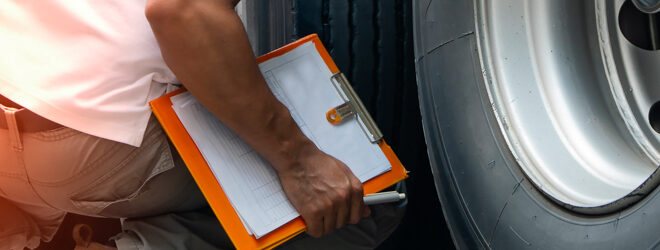Retreaded tires are nothing new, yet the topic can still divide fleet managers. While some have fully supported the innovation, others are hesitant to try retreads: can they really stand up to cross-country trips over rough terrain or on icy highways?
Of course, performance isn’t the only element to consider. When a damaged tire blows out, it can send shreds of rubber whipping across the lanes. This can ultimately put your truck and every vehicle around it in danger. You’ll want to make sure retreads can hold up in every situation, and that any savings you enjoy aren’t compromised by a greater safety risk.
Why use retreads?
Retreads have come a long way since their invention in the early 20th century, and today fleets of all sizes routinely retread the tires on their trucks. Here are a few reasons to consider choosing retreads over brand new tires:
Efficiency
Modern retreads are durable, and they’re not a one-time solution. Did you know that tires can be retreaded multiple times? That can translate to an extra 800,000 km of use before the tire is spent! Proper inflation can both increase performance and extend the life of the tire, allowing it to be retreaded up to three times.
Environmental impact
Clearly, retreads beat new tires when it comes to carbon footprint, since there’s less waste going to a landfill. In fact, a recent study in the UK found that retreaded tires produce 30 per cent less CO2 emissions than the average tire.
Savings
Tires are a huge expense for any trucking company – they’re right up there with fuel and payroll. If you can avoid replacing the entire tire, you should be able to save yourself a good amount of money.
Versatility
It may seem like retreads are only appropriate for specific circumstances; in reality, they’re generally fit for any terrain or season. The crucial point is that you match the tire to the application in order to increase fuel efficiency and prolong function.
Aren’t retreaded tires risky?
While early retread technology left something to be desired, times have changed. In fact, experts point out that the gators and tire scraps you’ll see on the highway are just as often from new tires as they are from retreads. In most cases, the problem comes down to improper maintenance, misalignment, overheating, and road hazards – not retreaded rubber.
Replacing old tires is simply not enough: you need to add frequent monitoring, professional maintenance, and good driving habits to the mix if you want your tires to perform safely and efficiently for as long as possible.
Driver training plays a big role in tire safety
Routine tire checks and better response to road hazards are keys to improving tire performance and safety, but your staff must commit to these steps for your business to benefit. As a business owner or manager, you need to effectively communicate the company’s best practices in order to reduce the risk of tire damage or disintegration.
As you compile your training and maintenance strategy, consider incorporating some smart tips to help prevent tire damage and failure, like:
- Check tires at least once a day, and during your pre-trip inspection.
- If you drive through road debris or over rough surfaces, be sure to inspect all tires at your next stop.
- Check tire tread and sidewalls for signs of damage. Look for punctures, excessive scuffing, or misalignment.
- If you find defects, don’t take the risk of driving with a damaged tire – replace the tire as soon as possible.
- Tire pressure can fluctuate more in cold weather. When the temperature dips, check tire pressures more frequently.
- Rotate, balance, and align tires periodically to ensure even wear.
- Choose an appropriate tire and tread design for the current weather conditions.
Invest in expertise
Knowing what to look for and how to fix tire problems can be more difficult than it seems. It’s imperative to work with tire professionals as needed, and raise the bar in the workplace with focused training and education. Here are just a few tips to keep in mind when it comes to tire maintenance:
- Experience is a virtue: consider using a professional tire installer to install, replace, and repair tires.
- Opt for a reputable tire supplier over the cheapest option.
- Educate maintenance staff on how to safely inspect all tires for defects and damage.
- Train drivers on how to identify the signs of tire failure and how to report defects according to company policy.
- Provide a defensive driving course that focuses on active road scanning and safely avoiding hazards.
Tire safety applies to the workplace, too. Use safety equipment like tire cages to protect staff from undetected hazards (such as zipper defects) during tire inflation, and make sure your equipment is always in good working order.
Protect your fleet with the right insurance
Although retreads have earned their good reputation for a number of reasons, accidents can and do happen. That’s when insurance can be helpful. To learn more about how a tailored policy can help protect you, your employees, and your bottom line, visit our Transportation & Logistics Services Insurance page today!




